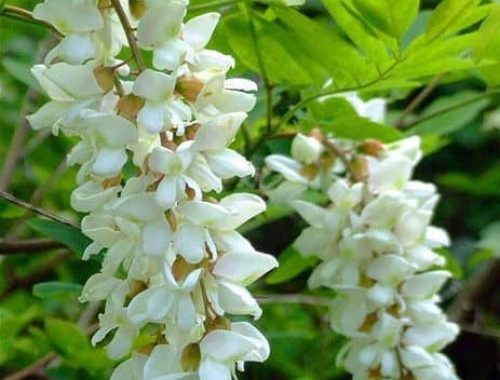WHITE ACACIA TREE AND ITS FLOWERS
(Robinia pseudoacacia)
(Robinia pseudoacacia)

White acacia tree has many names: black locust, robinia, robinier faux-acacia, honey locust, locust tree, etc. The wood of the tree is very strong and also durable. The wood is therefore used for making fence posts and railroad ties. It can also be used to make an efficient fuel. Due to its quick growth, it is also used by environmentalists to regulate soil erosion.
The flower can be eaten raw. It is also used for making acacia honey and acacia tea, but also for cakes and salads. Acacia flowers are often used as flavour enhancers due to their pleasantly sweet taste. Useful parts of the plant: flowers, wood, bark, leaves and seeds.
Healing effects of acacia
- Tea made from freshly picked or dried flower petals reduces catarrhal symptoms, relieves coughs
- Reduces gastric acid overload
- Diuretic when consumed in the morning
- Used for loose stools in the evening only as a cure, not continuously
- As a bath in case of vulvovaginal candidiasis or colds
- For the treatment of stress, insomnia, panic attacks, depression
The healing effects of acacia honey
- For upper respiratory diseases
- Immune system booster
- In case of indigestion
- Detoxifier
- Liver regenerator
- Bone strengthener
Other uses
- The blossoms are known for their diuretic, emollient and anti-spasmodic properties.
- Some also consume cooked flowers to relieve eye problems.
- The flowers contain components that are converted into quercetin and sugar after hydrolysis. They are even known to contain a chemical which may help to combat tumours.
- The crushed flowers help in healing of the skin after burns. They may be applied to the affected area and left on for a couple of hours.
- Hot tea from white acacia flowers helps to alleviate burning in the stomach and is helpful for people with gastritis; also good for treating cough, sore throat, bronchitis and asthma.
- Also used as a relaxing remedy for mental fatigue and nervousness.
- The inner bark and root bark of the tree helps to remove waste from the body. The root bark is sometimes chewed to induce vomiting. It may also be placed in the mouth to cure a toothache.
- The fruits, berries and seedpods are used as an analgesic due to their narcotic properties.
- The leaves are known to improve secretion and flow of bile. The juice obtained from the leaves may also help to fight against viruses. The dried leaves may be used to heal burns and wounds.
- The seeds are known to be rich in nutrients. The dried seeds contain calcium, protein, fat, fiber, phosphorus and many other vitamins and minerals in smaller amounts. They are boiled to reduce the bitterness and then consumed.
- The seedpods may also be eaten as they contain a sweet pulp.
